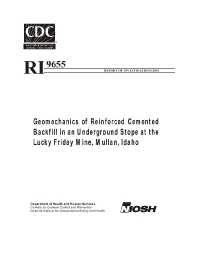Mining Publication: Geomechanics of Reinforced Cemented Backfill in an Underhand Stope at the Lucky Friday Mine, Mullan, Idaho
Original creation date: July 2001
Because backfill has occasionally collapsed into an active working area, posing a hazard to miners, engineers from the Spokane Research Laboratory of the National Institute for Occupational Safety and Health and Hecla Mining Company installed instruments in a cemented, backfilled, stope-ramp intersection at Hecla's Lucky Friday Mine, Mullan, Idaho. The purpose was to measure stress and strain changes in the backfill and reinforcing members during undercut mining. The instruments were monitored for 6 months while three successive cuts were mined below the intersection. Readings showed induced loads up to 3450 kPa (500psi) in the backfill as stope walls converged 2.5 to 12 cm (1 to 5 in.). The backfill then deformed against the top and bottom plates of the 2-m- (6-ft-) long vertical rock bolts installed as reinforcement, producing loads to 177 kN (40,000 lb) on the rock bolts. We hypothesize that a compressive zone was created in the backfill that allowed the backfill to remain stable as long as the compressive zones from adjacent rock bolts overlapped. This hypothesis is presented in graphical form. Of particular interest was the effect of loading on trusses installed to augment the vertical rock bolts and wire mesh typically installed in backfill. Data from the instruments indicate that wall closure perpendicular to the vein induced loads in truss legs parallel to the vein and in the rock bolt driven through the center of the truss, but, because they are designed to function under tension, truss legs perpendicular to the vein supplied insignificant support as a result of compressional forces from wall closure. Based on this study, use of trusses was discontinued, and an alternative support system of wood beams and posts was installed as needed to ensure the safety of miners working beneath the backfill in stope-ramp intersections.
Authors: TJ Williams, DK Denton, MK Larson, RL Rains, JB Seymour, DR Tesarik
Report of Investigations - July 2001
NIOSHTIC2 Number: 20021603
Spokane, WA: U.S. Department of Health and Human Services, Public Health Service, Centers for Disease Control and Prevention, National Institute for Occupational Safety and Health, DHHS (NIOSH) Publication No. 2001-138, Report of Investigations 9655, 2001 Jul :1-18
See Also
- 60 Years of Rockbursting in the Coeur D'Alene District of Northern Idaho, USA: Lessons Learned and Remaining Issues
- In Situ Stress at the Lucky Friday Mine (In Four Parts): 2. Analysis of Overcore Measurement From 5300 Level
- In Situ Stress at the Lucky Friday Mine (In Four Parts): 3. Reanalysis of Overcore Measurements from the Star Mine
- In Situ Stress at the Lucky Friday Mine (In Four Parts): 4. Characterization of Mine In Situ Stress Field
- Investigation of a Rock-Burst Site, Sunshine Mine, Kellogg, Idaho
- Make it Safer with Roof Screen
- A Medium Frequency Wireless Communication System for Underground Mines
- Musculoskeletal Stress on Miners Performing Roof Screening Operations
- New Tricks for an Old Elephant: Revising Concepts of Coeur d'Alene Geology
- Technical Bulletin Pager Phones: Installation
- Content source: National Institute for Occupational Safety and Health, Mining Program


 ShareCompartir
ShareCompartir
